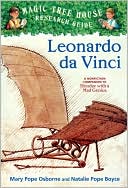List Books » Leonardo da Vinci: A Nonfiction Companion to Monday with a Mad Genius (Magic Tree House Research Guide Series)
Category Books
- Fiction Books & Literature
- Graphic Novels
- Horror
- Mystery & Crime
- Poetry
- Romance Books
- Science Fiction & Fantasy
- Thrillers
- Westerns
- Ages 0-2
- Ages 3-5
- Ages 6-8
- Ages 9-12
- Teens
- Children's Books
- African Americans
- Antiques & Collectibles
- Art, Architecture & Photography
- Bibles & Bible Studies
- Biography
- Business Books
- Christianity
- Computer Books & Technology Books
- Cookbooks, Food & Wine
- Crafts & Hobbies Books
- Education & Teaching
- Engineering
- Entertainment
- Foreign Languages
- Game Books
- Gay & Lesbian
- Health Books, Diet & Fitness Books
- History
- Home & Garden
- Humor Books
- Judaism & Judaica
- Law
- Medical Books
- New Age & Spirituality
- Nonfiction
- Parenting & Family
- Pets
- Philosophy
- Political Books & Current Events Books
- Psychology & Psychotherapy
- Reference
- Religion Books
- Science & Nature
- Self Improvement
- Sex & Relationships
- Social Sciences
- Sports & Adventure
- Study Guides & Test Prep
- Travel
- True Crime
- Weddings
- Women's Studies
Leonardo da Vinci: A Nonfiction Companion to Monday with a Mad Genius (Magic Tree House Research Guide Series) »

Authors: Natalie Pope Boyce, Mary Pope Osborne, Sal Murdocca
ISBN-13: 9780375846656, ISBN-10: 0375846654
Format: Paperback
Publisher: Random House Children's Books
Date Published: January 2009
Edition: (Non-applicable)
Author Biography: Natalie Pope Boyce
Book Synopsis
How did Leonardo da Vinci become interested in flight? What are some of his most famous paintings? Do his scientific ideas measure up to what we know today? Find out the answers to these questions and more in Magic Tree House Research Guide: Leonardo da Vinci, Jack and Annie’s guide to the mad genius himself.
Children's Literature
This clear and well-organized exploration of Leonardo da Vinci's life and accomplishments offers its readers additional information about the Renaissance master. The book begins with a two-page introduction from Jack and Annie. The seven chapters that follow are filled with black-and-white drawings and photographs of places, inventions, and art works. Margin drawings of Jack and Annie introduce brief definitions, opinions, and facts about Leonardo's notebooks and his artistic habits. The first of the book's chapters orients the reader to Leonardo's life and to central Italy in the Renaissance. The second chapter describes the city of Florence and Leonardo's life there as an apprentice to Verrocchio, an important artist of the time. It also briefly discusses Leonardo's work on his own as a painter and sculptor before he joined Duke Sforza's court in Milan. In the third chapter, Leonardo's ideas for inventions and experiments are introduced. Though he did not build most of them, he drew plans for such projects as armored cars, bridges, flying machines, submarines, cannons, parachutes, and special cities where sanitation would keep their citizens healthier. The next chapter describes Leonardo's scientific studies. He studied water movement and pressure, storms and weather, plants and fossils. When he studied human anatomy, he even learned to dissect bodies to better understand their composition. The fifth chapter focuses on Leonardo as artist and describes the new painting techniques he used, his studio and apprentices in Milan, and some of his famous works. One that was never finished was to have been a sixteen-foot tall bronze statue of a horse, but when the French invaded Milan thebronze had to be used for cannons. Two famous works that were completed were the The Last Supper and the Mona Lisa. The last chapter introduces other famous people of Leonardo's time, including the architect Leon Battista Alberti and Michelangelo Buonarroti, the painter and sculptor. The book is one of the "Magic Tree House Research Guides." Following the text is a section about undertaking research using books, museums, videos and DVDs, and the Internet. A five-page index completes the book. A "Stepping Stone Book." Reviewer: Judy DaPolito
Table of Contents
Subjects
 See All Subjects
See All Subjects  Art & Architecture
Art & ArchitectureAges 6-8
 See All Subjects
See All Subjects  Biography
BiographyAges 6-8
 See All Subjects
See All Subjects  History
HistoryAges 6-8
 See All Subjects
See All Subjects  Social Studies
Social StudiesAges 9-12
 See All Subjects
See All Subjects  Art & Architecture
Art & ArchitectureAges 9-12
 See All Subjects
See All Subjects  Biography
BiographyAges 9-12
 See All Subjects
See All Subjects  History
HistoryAges 9-12
 See All Subjects
See All Subjects  Social Studies
Social Studies
